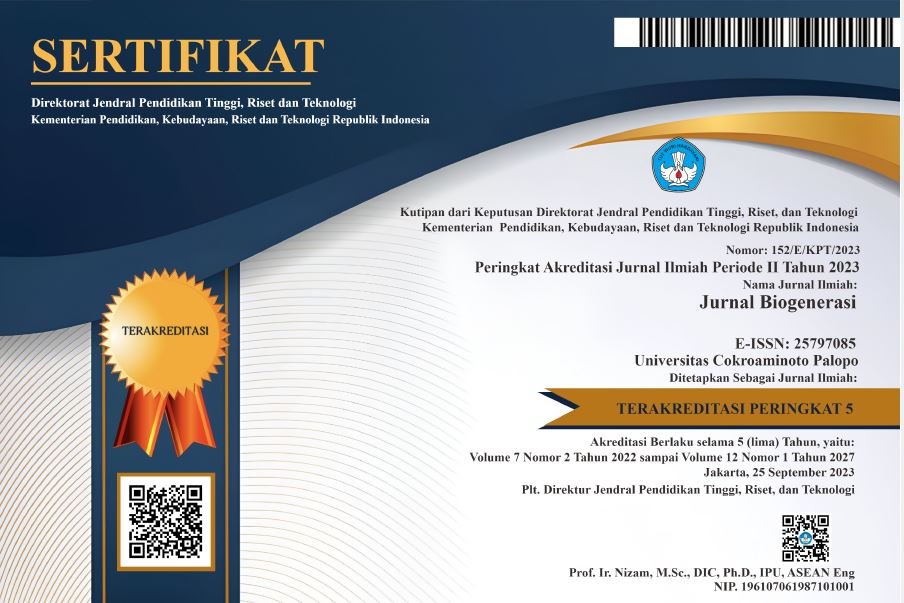PENGARUH JENIS KONSORSIUM BAKTERI PUPUK HAYATI TERHADAP EFISIENSI PUPUK ANORGANIK DAN PRODUKTIVITAS TANAMAN TOMAT (Solanum lycopersicum L.)
DOI:
https://doi.org/10.30605/biogenerasi.v10i2.5477Keywords:
Tomatoes, Bio-Fertilizer, Bacterial ConsortiumAbstract
The aim of this research is to analyze the effect of different types of organic fertilizer (solid biological, liquid biological and foliar) on the growth and productivity of tomato plants. This research was carried out for 3 months starting from February to April 2024. This research used a Randomized Block Design (RAK) consisting of 14 treatments, namely: solid biological fertilizer (100%), liquid biological fertilizer (100%) and foliar organic fertilizer (100%) with inorganic fertilizer doses of 25%, 50% and 75%. There were 14 treatment combinations with 3 repetitions. The observation variables are plant height, number of leaves, stem diameter and plant weight. The results of the research showed that the best treatment for plant height was liquid biofertilizer + 25% dose of inorganic fertilizer (83.47 cm), for number of leaves, namely liquid biofertilizer and leaf organic fertilizer (7 pieces), for stem diameter, 100% biofertilizer (6.20 cm) and for plant weight, namely organic leaf fertilizer + 75% dose of inorganic fertilizer (56.39 g).
Downloads
References
Ahmad, F., L. Ahmad. & M. S. Khan. 2005. Indole Acetic Acid Production by the Indigenous Isolates of Azotobacter and Fluorescent Pseudomonas in The Growth of Soybean (Glycine max L.). J Biol. 29: 29- 34.
Arora, N. K., Tewari, S., & Singh, R. (2013). Multifaceted plant-associated microbes and their mechanisms diminish the concept of direct and indirect PGPRs. In Plant Microbe Symbiosis: Fundamentals and Advances (pp. 411–449). Springer India.
Ashraf, M, A., Asif, M., Ahmad, Z, Arif, M., Qasim, A., Mahmood, R. 2013. Plant growth-promoting rhizobacteria (PGPR) and sustainable agriculture: a review. African Journal of Microbiology Research Vol. 7(9), pp. 704-709.
Badan Pusat Statistik (BPS). 2022. Produksi Tomat di Indonesia 2018-2022. Badan Pusat Statistik. Jakarta.
Cahyono, I., 2008, Tomat : Usaha Tani dan Penganganan Pasca Panen, Kanisius, Yogyakarta.
Fahmi, L., Rahayu, A., Mulyaningsih. 2017. Pengaruh Pupuk Hayati Majemuk Cair dan Pupuk Sintetik Terhadap Pertumbuhan Tanaman Edamame (Glycine max (L.) Merr). Jurnal Agronida. (3) 2:53-61.
Fitriani, I, Pujawati, S, Emma, T, S. 2017. Pengaruh Dosis Konsorsium Pupuk Hayati dan Dosis Nutrisi terhadap Populasi Bakteri Pelarut Fosfat dan Hasil Tomat (Solanum lycopersicum L.) pada Sistem Hidroponik. Soilrens Journal. Vol 15, No 1.
Fitriningtyas, A, N, Sutarno dan E. Fuskhah. Aplikasi beberapa jenis pupuk organik cair terhadap pertumbuhan dan produksi tanaman cabai rawit (Capsicum frutescens l.) (Applications of some liquid organic fertilizers on growth and production of cayenne pepper (Capsicum frutescens l.). J. Agro Complex 3(1):32-39.
Glick, B.R. 2014. Bacteria with ACC Deaminase can Promote Plant GrowthandHelp to Feed The World. Journal Microbiology Res. 30(9): P. 169.
Hanindita, Nisa. 2008. Analisis Ekspor Tomat Segar Indonesia. IPB: Bogor.
Herliana, O. Harjoso, T. A.H.S Anwar, A. Fauzi. 2019. The Effect of Rhizobium and N Fertilizer on Growth and Yield of Black Soybean (Glycine max (L) Merril). IOP Conf. Series: Earth and Environmental Science 255.
Hindersah, R dan T. Simarmata. 2004.”Potensi Rizobakteri Azotobacter dalam Meningkatkan Kesehatan Tanah”. Jurnal Natur Indonesia. 5(2), 127-133.
Kaya, E., Diana M., Marthin, K, A., Abraham, T., Anastasia T, H. 2020. Effects of Biofertilizer and NPK Fertilizer to Increase the Growth of Tomato (Solanum lycopersicum) Planted In Fusarium oxysporum Infected Soils. Agrologia : Jurnal Ilmu Budidaya Tanaman. Vol 9, No 2.
Mäder, P., Fließbach, A., Dubois, D., Gunst, L., Fried, P., & Niggli, U. (2002). Soil Fertility and Biodiversity in Organic Farming. Science, 296(5573), 1694-1697.
Marschner, P. 2012. Mineral Nutrition of Higher Plants. Academic Press. London.
Maulida, S, N., Djarwatiningsih, P, S., Guniari. 2022. Pengaruh Komposisi Media Tanam dan Konsentrasi Pemberian Pupuk Organik Cair Bonggol Pisang terhadap Pertumbuhan dan Hasil Tanaman Tomat (Solanum lycopersicum). Jurnal Pertanian AGROS Vol 24 (3):1129-1137
Nugroho, C. dan Hidayah. (2010). Penyisihan Logam Chrom Menggunakan Konsorsium Mikroorganisme. Ilmiah Teknik Lingkungan. 1: 16-19.
Purwati, E. dan Khairunisa, 2007, Budi Daya Tomat Dataran Rendah, Penebar Swadaya, Depok.
Rojas-Tapias, D., Moreno-Galvan, A., Pardo-Diaz, S., Obando, M., Rivera, D., & Bonilla, R. (2012). Effect of inoculation with plant growth-promoting bacteria (PGPB) on amelioration of saline stress in maize (Zea mays). AppliedSoil Ecology 61: 264-272.
Siregar, Bayo Alhusaeri. 2011. Teknologi Formulasi Pupuk Hayati Rhizobakteria dan Aplikasinya Sebagai Pemacu Pertumbuhan Tanaman Kedelai dan Biofungisida pada Tanah Masam. Tesis. Sekolah Pascasarjana Institut Pertanian Bogor.
Sudiarti, Diah. 2017. “The Effectiveness of Biofertilizer on Plant Growth Soybean ‘Edamame’ (Glycin Max).” Jurnal SainHealth 1(2):97.
Suraniningsih. 2010. Mari Berkebun Tomat. CV Sinar Cemerlang Abadi, Jakarta.
Susanto, Hendra, Ahmad Taufiq, Ari Gunawan, and Moch Sholeh. 2023. “Pemanfaatan Biofertilizer Kelor Untuk Efektivitas Smart Farming Berbasis Green House.” Semanggi: Jurnal Pengabdian Kepada Masyarakat 2(September 2022):13–22.
Suwahyono, U., 2011, Petunjuk Praktis Penggunaan Pupuk Organik Secara Efektif dan Efisien, Penebar Swadaya, Jakarta.
Yun S., Khazy A., Ramond S. 2020. Potensi Konsorsium Bakteri Pemacu Pertumbuhan Sebagai Bahan Aktif Pupuk Organik Hayati Pada Tanaman Jagung. Jurnal Agritech, Vol. 22: No. 2.
Zulaikah, D., Yuliani. 2018. Penggunaan Agen Hayati Rhizobium sp. dan Pseudomonas fluorescens terhadap Pertumbuhan Tanaman Kedelai (Glycine max) pada Tanah Salin Utilization Biological Agent Rhizobium sp. and Pseudomonas fluorescens on the Growth of Soybean (Glycine max) in Saline Soil. LenteraBio Vol. 7 No. 3: 226–230.
Downloads
Published
How to Cite
Issue
Section
License
In submitting the manuscript to the journal, the authors certify that:
- They are authorized by their co-authors to enter into these arrangements.
- The work described has not been formally published before, except in the form of an abstract or as part of a published lecture, review, thesis, or overlay journal.
- That it is not under consideration for publication elsewhere,
- That its publication has been approved by all the author(s) and by the responsible authorities – tacitly or explicitly – of the institutes where the work has been carried out.
- They secure the right to reproduce any material that has already been published or copyrighted elsewhere.
- They agree to the following license and copyright agreement.
License and Copyright Agreement
Authors who publish with this journal agree to the following terms:
- Authors retain copyright and grant the journal right of first publication with the work simultaneously licensed under Creative Commons Attribution License (CC BY 4.0) that allows others to share the work with an acknowledgment of the work's authorship and initial publication in this journal.
- Authors are able to enter into separate, additional contractual arrangements for the non-exclusive distribution of the journal's published version of the work (e.g., post it to an institutional repository or publish it in a book), with an acknowledgment of its initial publication in this journal.
- Authors are permitted and encouraged to post their work online (e.g., in institutional repositories or on their website) prior to and during the submission process, as it can lead to productive exchanges, as well as earlier and greater citation of published work.


.png)

